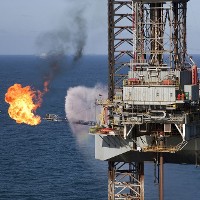26 February 2018
Ethane and propane emissions have been underestimated
A new study in Nature Geoscience, led by Norway’s Center for International Climate Research (CICERO) and including IIASA research, suggests that such revision could improve our understanding of related methane emissions, which is the second most important greenhouse gas and partly comes from similar sources. In turn, this may help to develop ways to lower emissions. Due to a long atmospheric lifetime (~12 years), methane is quite well-mixed in the atmosphere and it is therefore hard to distinguish the emission sources and regions responsible. This is easier for the heavier and shorter-lived hydrocarbons ethane (months) and propane (weeks), which come mainly from fossil-fuel extraction activities and to a lesser extent from natural sources.
“In this new study we compare the findings from simulations with an atmospheric chemistry transport model to measurement data and show that a substantial upward revision of emissions is needed,” said Stig Dalsøren, a former researcher at CICERO, now at the Institute of Marine Research, and first author of the study.
The team used an atmospheric transport model to compare how country-reported emissions inventories compared to observed atmospheric concentrations of ethane and propane picked up at 27 different monitoring stations around the Northern hemisphere, to find the discrepancy.
“Hydrocarbon emissions from fossil fuel sources are underreported in national emission inventories, with the latter only explaining about half of the atmospheric ethane and propane concentrations that are measured at different monitoring stations around the Northern hemisphere. Since most of atmospheric ethane and propane comes from oil and gas activities, underreporting of these hydrocarbons can likely be referred to these activities,” says IIASA researcher Lena Höglund-Isaksson.
Major detailed atmospheric model studies performed so far have neglected natural geologic emissions of hydrocarbons. Natural geologic emissions include mud volcanoes, gas seeps, diffuse exhalation from petroleum basins, submarine seeps, geothermal manifestations, and volcanoes. For man-made sources, this study is the first to use two recently published fossil fuel (oil, natural gas, and coal) emission datasets.
The first is based on Höglund-Isaksson’s work, which uses extensive country-level data on flows of associated petroleum gas (APG) to estimate considerably higher hydrocarbon emissions from APG venting than is currently assumed. In existing national and global inventories, it is generally assumed that gas flares at oil wells operate at all times, but this is not the case, for example due to unfavourable weather conditions or maintenance. Excess hydrocarbons like methane, ethane and propane are then simply vented without being burned. Höglund-Isaksson includes these emissions.
The second inventory is based on work by Stefan Schwietzke at the National Oceanic and Atmospheric Administration (NOAA) who derived his own global bottom-up emission inventory for ethane from fossil fuel industry and compiled a global database on source-specific isotopic compositions of gases released from fossil fuels, microbial and burning sources.
“Compared to previous inventories, these new datasets are based on novel approaches, and more extensive databases considering country-specific circumstances, resulting in highly different geographical emission distributions and 2-3 times higher global total emissions”, said coauthor Gunnar Myhre, research director at CICERO.
Using the new fossil fuel emission datasets and adding the geologic emissions, the applied atmospheric model reproduces observed current ethane and propane levels in the Northern Hemisphere, including episodic fluctuations.
Höglund-Isaksson explains that the finding that emissions are underestimated has been shown before, but this is the first research to offer possible explanations for what is missing from the existing emissions inventories. This can in turn lead to improved estimates.
Ethane and propane are the most abundant non-methane hydrocarbons in the atmosphere, and yet their emissions, distribution in the atmosphere, and trends in their atmospheric concentrations are insufficiently understood. Through chemical reactions in the atmosphere, ethane and propane affect the formation and loss of several air pollutants and greenhouse gases. Direct emissions at the surface, natural or man-made, are the only sources of ethane and propane to the atmosphere.
Text adapted from a press release by the Center for International Climate Research (CICERO), Norway
Reference
Dalsøren SB, Myhre G, Hodnebrog Ø, Myhre CL, Stohl A, Pisso I, Schwietzke S, Höglund-Isaksson L, Helmig D, Reimann S, Sauvage S, Schmidbauer N, Read KA, Carpenter LJ, Lewis AC, Punjabi S, & Wallasch M (2018) Discrepancy between simulated and observed ethane and propane levels explained by underestimated fossil fuel emissions. Nature Geoscience [pure.iiasa.ac.at/15138/]

RESEARCH PARTNERS
PUBLICATIONS
NEWS
"Climate Modernity" - The 24H Challenge: How do we want to live and act in the future in Styria ?
Health fears can increase pandemic isolation habits in older Europeans
How circular waste management systems can benefit the environment
Launch of the Northern African Applied Systems Analysis Centre
How we measure the effects of methane matters for climate policy


